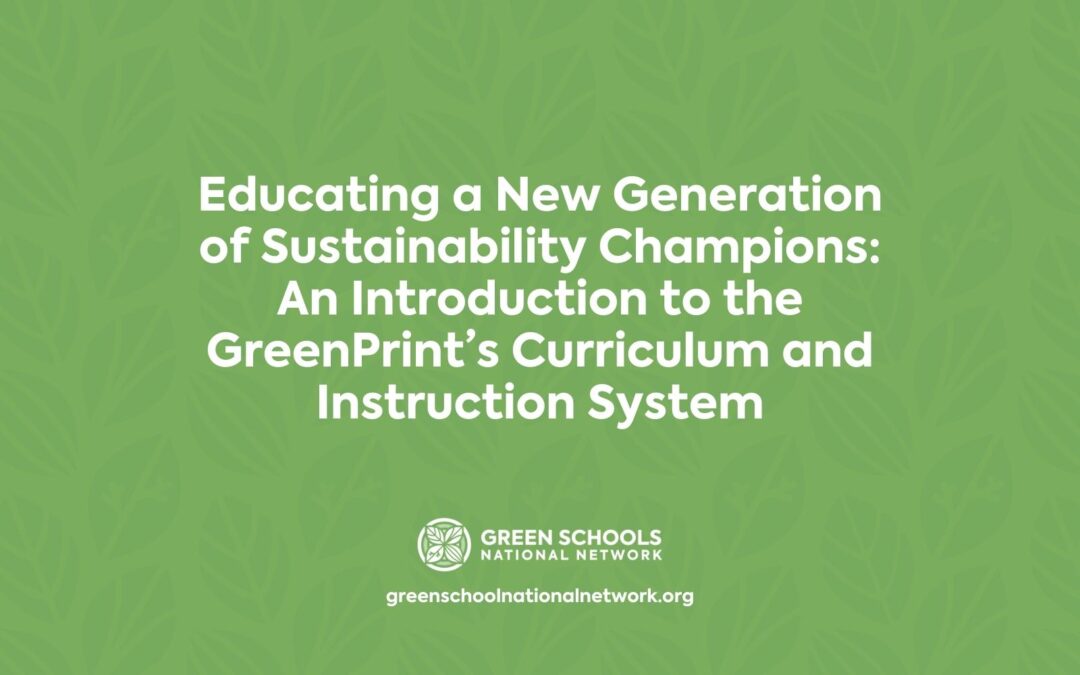Curriculum and instruction that prepares students to be sustainability champions is the life-blood of healthy, equitable, and sustainable schools. This isn’t your run-of-the-mill, textbook-based curriculum. In these schools the curriculum is hands-on, minds-on, and culturally relevant, empowering students to design solutions to real problems in their communities. The instruction that supports such curriculum is engaging, experiential, interdisciplinary, and purposeful. It builds students’ confidence and competence as agents of change for social and environmental justice.
The five core practices that make up the Curriculum and Instruction System in Green Schools National Network’s updated GreenPrint provide a blueprint for designing and implementing high-quality curriculum and instruction that centers health, equity, and sustainability. This article provides an overview of these practices and shares a few examples of them in action at California’s Environmental Charter Schools.
Setting the Stage for High-Quality Curriculum and Instruction
Core Practices 6 and 7 under the GreenPrint’s Curriculum and Instruction System create structures and conditions that are needed to shape curriculum and instruction in healthy, equitable, and sustainable schools.
A key step is creating a comprehensive curriculum and instruction plan that aligns with the school’s strategic plan and includes goals and metrics that can be used to measure progress. The plan should also include professional learning opportunities and planning time to support teachers in their efforts to design and implement high-quality curriculum and instruction. Professional learning is important since teachers may not have much experience with or knowledge of 4PBL or curriculum and instruction that centers health, equity, and sustainability.
Another key step is updating the curriculum itself. Lessons and units should incorporate multiple core subject areas and focus on topics that are developmentally appropriate for each grade level. They should also invite students to explore and learn from the community beyond the school’s walls, build cultural knowledge and an understanding of diverse perspectives, and build action competence – the desire and ability to solve problems in the world outside of the classroom.
In 2016, Environmental Charter High School in Lawndale, California began to shift toward an ethnic studies pedagogy across all courses. Professional learning was essential to introduce teachers to ethnic studies through resources, guest speakers, discussion groups, and sample lessons. Through education and interaction with students, teachers made changes and updates to lessons using an ethnic studies lens and reinvented “outdoor trips” to include visits to urban environments and opportunities to build solidarity across ethnic and racial groups.
An Integrated Approach to Curriculum through 4PBL
What and how students learn is the focus of Core Practices 8 and 9. Curriculum and instruction in healthy, equitable, and sustainable schools uses an integrated approach that embeds sustainability topics across all grades and core subjects areas, not just science and social studies. Learning is developmentally appropriate – students learn to love the Earth first, then to save it – progressing from developing empathy for the world and exploring its varied ecosystems, to learning to identify with natural and human communities and building action competence to address social and environmental issues occuring in those communities.
This integrated approach to learning is driven by four pedagogical practices: phenomena-, place-, project-, and problem-based learning (or 4PBL). In the classroom, 4PBL goes something like this: the teacher links current events or issues (phenomena) to local problems to teach students knowledge and skills required by content standards (place). Students use their newly acquired knowledge and skills to solve community problems (problem) or create a project that shows how a current event or issue impacts their community (project). You can learn more about 4PBL in this Green Schools Catalyst Quarterly article, which includes several short case studies that show what 4PBL looks like in action.
Student-Centered Assessment Deepens Learning
Assessment is the focus for Core Practice 10, the final core practice in the Curriculum and Instruction system. Assessing student learning in healthy, equitable, and sustainable schools goes beyond traditional performance-based assessment and formative assessment methods. Assessment is primarily student-centered with opportunities for students to apply and demonstrate their knowledge and skills in hands-on, real-world ways. Students are encouraged to use a combination of written, visual, and verbal products (e.g., reports, models, presentations) to share their ideas and understandings and often present these products before an authentic audience of experts, who provide feedback and dialogue, both essential for building critical thinking and presentation skills.
Students at Environmental Charter Schools are no strangers to this type of assessment. Here, learning is measured using Interdisciplinary Benchmark Assessments (IBM), their version of a midterm or summative final. In one IBM, students were asked to look at gentrification in Inglewood, California and the impact of building a renewable energy facility. Students created a 3D blueprint of a sustainable Inglewood community and a brochure that detailed the problems they wanted to solve and why. In a final act of demonstrating their learning, students were given ten minutes to pitch their proposals to a board of decision-makers that included school administrators, academic coaches, teachers, and staff.
It’s no secret among healthy, equitable, and sustainable schools – 4PBL is the key to increasing student engagement, deepening learning, and breathing life into standards. While this cross-curricular approach may not happen all day, every day, it’s still an integral component of learning in these schools, allowing students to build knowledge, skills, and mindsets for taking action in their school, communities, and the world.
Want to learn more about 4PBL? Join Green Schools National Network and connect with educators practicing 4PBL in their classrooms.

